Bird flu pandemic preparedness activities are not evidence of a conspiracy
Recent social media posts have baselessly suggested that a new, lab-derived version of the H5N1 virus is going to cause a pandemic
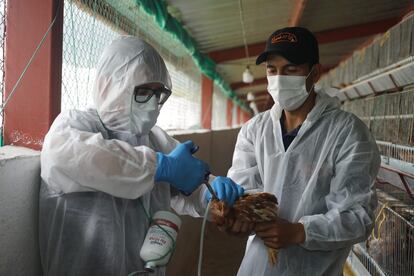
Flu viruses have a long history of making animals and humans sick. This includes a track record of causing pandemics, which can occur when unfamiliar viruses begin to spread widely among humans. Recently, a type of bird flu — called H5N1 — has been spreading among poultry, dairy cows and wild animals in the U.S. and infecting some farmworkers, adding to existing concerns about the virus’s pandemic potential.
The U.S. government, in collaboration with others around the world, has a history of flu pandemic preparedness activities, including monitoring the flu viruses circulating in people and certain animals and stockpiling relevant vaccines and antivirals. These activities are meant to ensure scientists spot any concerning changes to flu viruses’ genetics or circulation early and to give the government a head start on taking measures intended to save lives in the event of substantial flu spread.
However, social media posts in recent weeks have baselessly implied that ongoing flu pandemic preparedness efforts are evidence that a new laboratory-derived version of the virus is going to cause a pandemic — or even that there is a conspiracy to release bird flu from a lab.
In a July 26 post on X, for instance, independent presidential candidate Robert F. Kennedy Jr. misleadingly framed efforts to ensure access to bird flu vaccines on the part of the Department of Health and Human Services. “Why would you need this vaccine, unless you expected a much more virulent virus to appear which had mysteriously gained the ability to spread between humans?” Kennedy said. “Will there be another lab-derived pandemic? Not on my watch!” Kennedy’s claims have since spread on other social media platforms.
Kennedy also got some details wrong about the HHS flu preparedness efforts, incorrectly claiming that the U.S. Food and Drug Administration can currently issue an emergency use authorization for bird flu vaccines and that stockpiled vaccines contain a “dangerous” ingredient.
Kennedy has a history of making false or unsupported claims about the origins of infectious diseases and other health topics. There isn’t proof of how the COVID-19 pandemic started, and a lab accident has not been excluded. However, many scientists say the most likely explanation is that the virus spread to people from animals being sold via the illegal wildlife trade, and that evidence for a lab leak is lacking. There is no evidence the coronavirus was bioengineered and all U.S. intelligence agencies agree that it was not developed as a biological weapon.
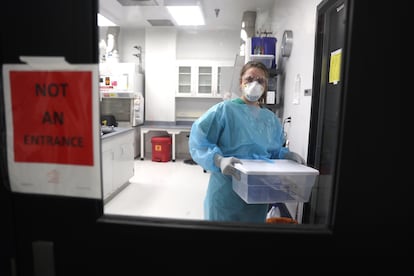
Another post referred back to the COVID-19 pandemic as the source of a “playbook” involving a lab-made virus. “They want us to take another experimental vaccine to combat the bird flu virus, which they created in a lab,” said conservative commentator Liz Wheeler in a video posted Aug. 7 on Instagram. Wheeler baselessly implied that vaccine preparedness efforts are a sign the “globalists” are going to “unleash” the virus.
Posts also have illogically implied that the existence of scientific meetings about bird flu mean there is a pandemic-related conspiracy. For instance, a July 28 Instagram post referenced an upcoming summit on bird flu, which begins Sept. 30 and is focused on bird flu and other diseases in livestock, as evidence there is going to be a “plan-demic” and referred back to “Event 201.” The misinformation-laden video “Plandemic,” released in 2021, baselessly argued that the COVID-19 pandemic was caused by a virus that was created by humans and released on purpose. It misleadingly cited Event 201 — a standard pandemic preparedness exercise held in 2019 — as evidence that the pandemic was planned.
It’s normal for scientists to have meetings to discuss their field of study. And pandemic preparedness meetings are held to plan for what to do in the case of a pandemic, not to intentionally plan to unleash infectious diseases.
Further, laying the groundwork to potentially offer vaccines against flu viruses of concern is “exactly what we should be doing for pandemic preparedness because we know these viruses have the ability to jump from animals to people,” Stacey Schultz-Cherry, a virologist at St. Jude Children’s Research Hospital, told us. “We’ve seen that through history with influenza virus.”
While scientists have not seen the sorts of changes in H5N1 bird flu that would allow it to spread readily between people, she said, it is normal procedure to be proactive when a bird flu virus is seen to be infecting humans. “We want to make sure we have an arsenal so that we’re not caught surprised,” she said, referring to the importance of preparing to offer vaccines as well as antivirals.
Bird flu vaccines could be used in the event of a pandemic, Schultz-Cherry said. Or, as is currently being done in Finland, they could be offered to at-risk workers who might be infected with bird flu outside of a pandemic. “You could theoretically give them this vaccine as a preventive measure,” she said.
Research involving H5N1 bird flu has a long history of scrutiny, given the risks of working with viruses considered to have pandemic potential.
The social media posts currently circulating, however, do not provide any evidence that there is now an elevated risk of a bird flu escaping from a laboratory, nor that this concern is motivating current pandemic preparedness activities.
When asked via email if HHS bird flu preparedness activities are related in any way to an expectation of a lab-derived pandemic, a spokesperson for the agency replied, “No.”
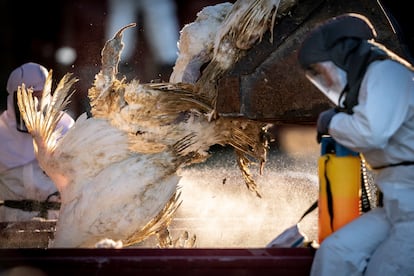
Meanwhile, the circulation of H5N1 bird flu in wild and domestic animals and the infections seen in humans do provide a clear motivation to prepare bird flu vaccines and antivirals.
The four flu pandemics since 1900, which varied in severity, all occurred after novel flu viruses spread to people from animals.
The scientific community has been monitoring the H5N1 bird flu family of viruses since 1997, when infected poultry sickened and killed people in Hong Kong, Schultz-Cherry said.
Flu viruses are named based on the subtypes of two proteins on their surfaces, called hemagglutinin and neuraminidase, or H and N. None of the human seasonal flu viruses have H5, although they can include versions of N1 or N2.
As we explained in a prior article, the current group of H5N1 viruses circulating in North America was first found in wild birds in the U.S. in 2021. The virus has gone on to kill many wild birds and poultry, as well as show up in various mammals. H5N1 bird flu likely began to spread in dairy cows in late 2023 — primarily affecting the mammary glands — although the infections were not identified until this past March. Between 2022 and late July of this year, the virus caused mild infections in at least 14 U.S. dairy and poultry workers. (We periodically update our article “Q&A on H5N1 Bird Flu” with information on new human cases of the virus.)
Any situation that puts a new population of people and animals in contact with bird flu creates opportunities for the virus to change or swap parts with other flu viruses in ways that might prove dangerous to people, researchers previously told us.
This is why the U.S. is focusing on making sure farmworkers have access to regular seasonal flu vaccines, to reduce the risk that they get infected with seasonal flu and bird flu at the same time or spread seasonal flu to an animal. Infection with two types of flu viruses at once can allow the viruses to swap parts, a process known as reassortment.
“We need to understand more than anything what is happening at these interfaces” between wild birds, domestic animals and humans, Schultz-Cherry said. “That is where we need to understand what is happening … because that is where these changes can occur” that can spark pandemics.
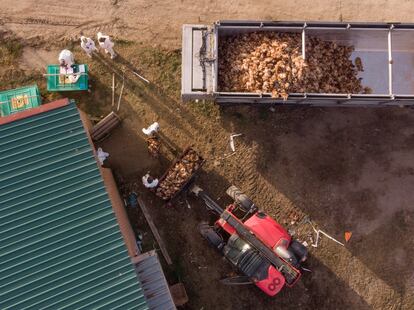
Kennedy emphasized the mildness of the cases so far in humans in his post, implying that it is suspicious that the government would engage in preparations for a mild disease.
Indeed, the mildness of recent cases in the U.S. and prevalence of infections affecting only the eyes may mean this current version of the virus is “not well suited to sicken people,” Schultz-Cherry said. But we do not have full information on the percentage of people who would become severely ill if infected, she said.
As we’ve written before, more than half of all people around the world known to have had H5N1 since 2003 have died, although this is likely an overestimate of the virus’s lethality.
We also know from history that it is difficult to predict which viruses will spark a pandemic, when this will happen and how dangerous the viruses will be. And even a virus that kills a relatively low percentage of people can do substantial damage if it spreads widely.
Posts Confuse Details on Flu Preparedness Steps
Social media posts are broadly right that the U.S. government and others are taking flu preparedness actions, but they get some details wrong. Kennedy, whose campaign recently indicated to the New Yorker that his ambitions include being HHS secretary, made incorrect claims about actions HHS has taken to secure bird flu vaccines.
“HHS Secretary Becerra just issued a PREP Act declaration for bird flu,” Kennedy said in his X post. “This allows the FDA Commissioner to issue EUAs for bird flu vaccines, with no liability,” he said, using an abbreviation for the Public Readiness and Emergency Preparedness Act.
But a spokesperson for HHS told us via email that there has been no “new” PREP Act declaration.
An older influenza-related PREP Act declaration, most recently amended in January 2023 to be extended through 2027, would apply to H5 influenza vaccines, if any are “authorized or approved by the FDA,” the spokesperson said.
Dorit Reiss, a professor at UC Law San Francisco who studies vaccine policy and law, explained in an email that PREP Act declarations do give a certain level of immunity “for liability for a measure used in an emergency.” As we’ve explained in prior articles, people cannot sue a manufacturer after receiving vaccines covered under the PREP Act unless there is a death or serious injury caused by “willful misconduct.”
Arrangements like those outlined in the PREP Act are “very common in the vaccine field, and over 20 other countries have similar schemes in place,” Ana Santos Rutschman, a law professor at Villanova University who also studies vaccine law and policy, told us in an email. The liability protection reduces the risks for vaccine manufacturers associated with bringing a new vaccine to market, she said. People claiming harm from vaccines can apply to get compensation from a government program.
Contrary to Kennedy’s post, the FDA is not currently able to issue EUAs “for products for H5N1,” the HHS spokesperson said. Multiple steps are needed to allow the FDA to issue an EUA, the spokesperson explained, including an EUA declaration from the secretary of HHS. There has been no such declaration.
Kennedy’s campaign did not reply to an email requesting clarification. But it is possible that Kennedy was thinking of a recent influenza-related amendment, made on July 18 by HHS Secretary Xavier Becerra.
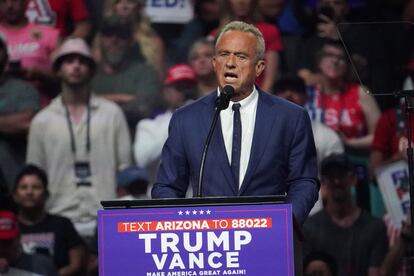
The recently issued amendment broadens a determination made in 2013 that originally applied to a specific type of bird flu, called H7N9, that can also sicken and kill people. The determination — stating that the viruses pose “a significant potential for a public health emergency” — now applies to a broader group of pandemic flu viruses or flu viruses with pandemic potential, including H5N1.
The new amendment allowed the Centers for Disease Control and Prevention to issue emergency use instructions for the antiviral drug oseltamivir, or Tamiflu, the HHS spokesperson said. The drug is already approved to treat and prevent flu. The emergency use instructions provide some guidance related to H5N1 and other novel flu viruses that goes beyond the FDA-approved label for the drug.
The new amendment also “triggers the possibility of EUAs, including for biologics such as vaccines,” said Rutschman.
However, as we’ve explained, it is not currently possible for the FDA to issue EUAs for H5N1 products, even with the new amendment. “The amendment doesn’t enable the EUA but it is accurate to say it’s a step in the process,” the HHS spokesperson said.
HHS is also taking steps to ensure H5 vaccines are available if needed, the spokesperson said. As supposed evidence of a larger plot, Kennedy cited in his post an agreement the government made with the company CSL Seqirus to supply 4.8 million doses of “bird flu” — presumably referring to bird flu vaccine — which he claimed uses “a dangerous squalene-containing adjuvant.” Adjuvants are ingredients that are added to vaccines to make them more effective.
The Biomedical Advanced Research and Development Authority, or BARDA, which is a part of HHS, regularly works with pharmaceutical companies to maintain a stockpile of flu vaccine ingredients, targeted against potentially concerning emerging flu viruses, as well as small quantities of pre-filled vials and syringes.
BARDA finalized a deal with CSL Seqirus in May 2024 to supply around 4.8 million additional H5 bird flu vaccine doses filled into vials, which BARDA will keep in its National Pre-Pandemic Influenza Vaccine Stockpile.
But the acquisition of filled vaccine vials doesn’t mean HHS knows whether or not there will be an H5 bird flu pandemic. “While this increases the range of options if vaccines are needed, this is squarely still in what we would consider our preparedness efforts,” the HHS spokesperson told us.
Kennedy’s claim about squalene — a naturally occurring substance found in the human body — is unfounded. The squalene-based adjuvant MF59 included in the company’s H5 bird flu vaccine is already used in an approved seasonal flu vaccine and has an “excellent safety record,” according to the CDC. A 2006 report from the World Health Organization said that safety data on 22 million doses of the seasonal flu vaccine suggested that MF59 “poses no significant risk.” Various subsequent studies have borne out that MF59 is not associated with an increased rate of serious side effects, although MF59-containing flu shots may come with an elevated rate of more minor side effects, such as injection site reactions.
BARDA also has stockpiles of materials for other H5 vaccines. And the agency is working with Moderna to produce an H5N1 mRNA vaccine as part of “the agency’s ongoing preparedness actions,” according to the BARDA website.
Finally, both Kennedy and Wheeler, the conservative commentator, also referred to efforts by the American Medical Association to issue provisional Current Procedural Terminology codes for H5 influenza vaccines. If a vaccine were given an emergency use authorization, medical professionals could use the codes to report vaccinations and related activities, an AMA press release said. Once again, this preparatory step isn’t indicative of anything other than proper planning.
The HHS spokesperson added that the agency is also making goggles, gloves, N95 masks and face shields available from the Strategic National Stockpile, as well as allowing affected people and states to request oseltamivir from this stockpile if needed.
Personally Stockpiling Tamiflu Not Recommended
Despite claiming that flu preparedness measures are evidence of a conspiracy, some social media posts themselves promote a version of a flu preparedness measure: a “contagion emergency kit,” sold by The Wellness Company for $324.99. We’ve written that The Wellness Company has sold COVID-19-related products based on unfounded medical claims.
Wheeler, for instance, said that the kit “has everything that you or I will need to combat this lab-created virus that I’m sure the globalists are going to unleash on us,” referring to H5N1 bird flu and listing ivermectin and hydroxychloroquine as components, while telling followers to buy it using her promo code.
The “guidebook” that accompanies the kit suggests these two drugs are treatments for COVID-19 and other diseases, although clinical trials have shown these drugs are not effective for treating COVID-19. For bird flu, the kit offers oseltamivir, or Tamiflu, which is indeed an antiviral drug that may offer some benefit against the disease.
But Schultz-Cherry did not recommend that people purchase oseltamivir out of theoretical concern they might get bird flu. “It’s not something that will stay [good] in your cupboard forever,” she said, and it’s important to ensure there’s enough supply available for the upcoming regular flu season.
This article first appeared on August 22 on Factcheck.org
Sign up for our weekly newsletter to get more English-language news coverage from EL PAÍS USA Edition
Tu suscripción se está usando en otro dispositivo
¿Quieres añadir otro usuario a tu suscripción?
Si continúas leyendo en este dispositivo, no se podrá leer en el otro.
FlechaTu suscripción se está usando en otro dispositivo y solo puedes acceder a EL PAÍS desde un dispositivo a la vez.
Si quieres compartir tu cuenta, cambia tu suscripción a la modalidad Premium, así podrás añadir otro usuario. Cada uno accederá con su propia cuenta de email, lo que os permitirá personalizar vuestra experiencia en EL PAÍS.
¿Tienes una suscripción de empresa? Accede aquí para contratar más cuentas.
En el caso de no saber quién está usando tu cuenta, te recomendamos cambiar tu contraseña aquí.
Si decides continuar compartiendo tu cuenta, este mensaje se mostrará en tu dispositivo y en el de la otra persona que está usando tu cuenta de forma indefinida, afectando a tu experiencia de lectura. Puedes consultar aquí los términos y condiciones de la suscripción digital.
More information
Archived In
Últimas noticias
Chris Martin, Taylor Swift, Elijah Wood and other famous wedding ‘crashers’
‘How does it feel to be a failure?’: Elizabeth Berkley’s journey from ‘Showgirls’ ridicule to vindication
The story of the Málaga virus: The code that haunted Google’s cybersecurity center director for 30 years
The impact of Ecuador’s mega-prison: A polluted river, cleared forests and military checkpoints
Most viewed
- Christian Louboutin: ‘Young people don’t want to be like their parents. And if their parents wear sneakers, they’re going to look for something else’
- The low-cost creative revolution: How technology is making art accessible to everyone
- Liset Menéndez de la Prida, neuroscientist: ‘It’s not normal to constantly seek pleasure; it’s important to be bored, to be calm’
- All the effects of gentrification in one corner of Mexico’s Colonia Roma
- December Social Security and SSI payments: Dates, double checks and the 2026 COLA increase










































